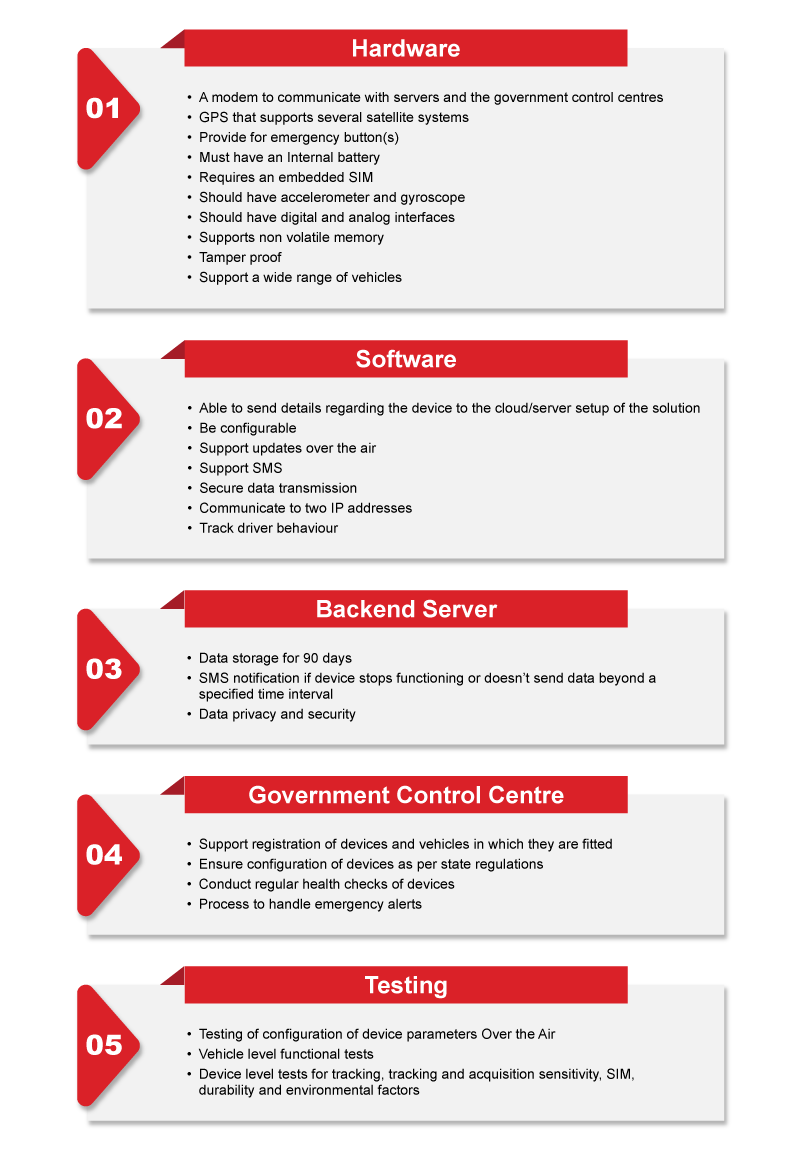
As road networks improve across the country, and more roads get built, the number of vehicles coming on roads is growing by leaps and bounds. This leads to traffic congestion which can prove to be a daily challenge for all types of commuters, drivers, traffic police and others. By using an intelligent transport system (ITS), services related to traffic management and modes of transport can be built which help users have better access to information to leverage transport networks in a more efficient, timely manner. With growing concerns related to safety and security of citizens, especially women and children, having an intelligent transport system in India has gained significance in recent times. Government bodies and transport related bodies in India have been working towards implementing various components of ITS in India.
The Automotive Industry Standards Committee constituted under the aegis of the erstwhile Ministry of Surface Transport has worked on a standard for this, the AIS-140, entitled “Intelligent Transportation Systems (ITS) – Requirements for Public Transport Vehicle Operation”. It identifies the necessary elements for an effective implementation of vehicle level ITS system.
While the deadline for public transport vehicles to have devices that are AIS-140 compliant has been extended, the market is already seeing the launch of devices that claim to be AIS-140 ready or or AIS-140 gps device manufacturers.
As a GPS tracking solution provider in India, you will need to be well versed with the standard so that your solutions make use of the right devices that are reliable as well as fully compliant. The AIS-140 is a comprehensive document that details out the specifications. It covers the hardware requirements in detail, what the software for the device must be capable of doing and communicating, what the backend servers of the system should be like, how the communication must happen with government transport control centres and what is required at these control centres.
We have simplified the key points from the draft, so it becomes easy for you to understand the specifications.

Hardware
Let’s first look at the GPS tracking device itself. What does the standard say the device should be? Here are the components the device must have:
A modem: The device needs to communicate with servers and the government control centres, so a modem is a must. The standard gives full specifications for the modem.
GPS: It should have a GPS tracker that supports the Global Navigation Satellite System, the Indian Regional Navigation Satellite System and GAGAN, the Indian Satellite Based Augmentation System. The standard defines the position accuracy, the minimum acquisition sensitivity of the GPS component, as well as the minimum tracking sensitivity. With these specifications, the device is able to share data that is reliable and recent.
Emergency Button(s): The device will have emergency buttons, on pressing of which alerts will be sent to the IP addresses configured. The number of buttons are different for different vehicles. For example, a passenger car shall have two buttons for every seating row as well as a dedicated one for the driver. A passenger bus shall have easily visible and accessible buttons, every 2m or so, as well as a dedicated button for each row of seats reserved for ladies.
Internal battery: The device should have an internal battery backup to support four hours of normal operations.
Embedded SIM: The device shall have an embedded SIM, so it’s chip-based SIM, and not like the regular card based SIMs. It must allow for changing the network provider, if needed. It should provide a life span of at least 10 years and more than 1 million read/write cycles.
Accelerometer and gyroscope: The device should have a 3-axis accelerometer and 3-axis gyroscope for getting alerts on harsh braking, harsh acceleration, and rash turning.
Digital and Analog interfaces: The device must provide for adding on sensors. It must have four digital, two analog, one serial port, and one for emergency button extension.
Non volatile memory (flash memory): A vehicle may not always be in an area with full network connectivity. So the device needs to be able to store data in such conditions.
Tamper proof: The device shall be tamper proof and must be resistant to dust, temperature and water splashes (IP65 rated or better). It shall be manufactured as per quality management standards defined for automotive industries.
Support a wide range of vehicles: The standard defines the DC range of device operation, 8V to 32V. This means that the same device should be able to support many different types of vehicles.
| How the Emergency Button Should Work
As per the AIS-140, passengers or crew present in the vehicle should be able to make an emergency request by pressing the emergency button. When this button is pressed, an emergency alert is sent to the configured IP address(s). If there is no data network available, the alert shall be sent as an SMS message along with vehicle location data to the configured control center number(s). The emergency request function must be part of the Vehicle Location Tracking (VLT) system. The button will be so designed that it is easy to press in the case of an emergency, but also minimizes the possibility of accidental or unintended presses. |
Software
What should the software component of the GPS tracking device be able to do? It should be able to send details regarding the device to the cloud/server setup of the solution. These details include device registration data, device configuration data, device login, location, alerts, emergency button alerts, and information regarding the vehicle health. It should also send the vehicle number. The standard requires that the device send this data at 10 minute intervals, even when the vehicle is turned off.
Other than these, the AIS 140 standard also prescribes the following:
Configurable: The device should be configurable to enable some functionalities. For example the software should allow changing the settings for the logging frequency, and the frequency of posting to server.
Updates: The device should support Firmware updates Over The Air (FOTA).
Support SMS: In the event of the vehicle not in an area with good data network connectivity, the information regarding the vehicles must still be sent to the backend servers. For this reason, SMS based operations are mandated. And if there is no network available it should be able to save data offline as well.
Secure data transmission: The data being sent should be via secured channels. For example, this could be through a secure dedicated APN.
Two IP addresses: In case of an emergency alert, the device should be able to send data to two different IP addresses simultaneously.
Driver behaviour: While the hardware mandates include having accelerometers and gyroscopes to detect hard braking, and so on, the software should be able to pick this information intelligently to convey how safe the driving is.
Backend Server Requirements
The AIS-140 has provisioned for some requirements which are to be handled at the backend server level. They include the following:
- Historical data should be stored for 90 days.
- If the device stops functioning, an SMS notification has to be sent to the vehicle owner.
- If a devices doesn’t send data beyond a certain time interval (1 day, 7 day, etc), then a notification must go to the vehicle owner from the server.
- The server should maintain security and privacy of data.
Testing
The standard also covers certain functional testing requirements that must be met by device manufacturers. These include:
Testing of configuration of device parameters Over the Air (OTA): For example, the test should check if the settings for the primary and secondary IP addresses can be changed, whether parameters for harsh braking can be set, over the air.
Vehicle level functional tests: These include vehicle location tracking with emergency button. For instance, the system must transmit the Position, Velocity and Time (PVT) details of the vehicle to the government control centre.
Device level tests: These include tests for tracking, location accuracy, acquisition sensitivity, tracking sensitivity, the time it takes to determine its first location fix in various conditions, SIM, and so on. There are performance and durability tests for the device and see how well it performs against shocks, vibrations, dust and water ingress, etc. The device shall be subjected to dry heat, cold, damp heat, temperature shock, and several other environmental tests. Protocol testing also needs to be done which covers a range of parameters, from vehicle number to mobile network code and internal battery voltage. Along with protocol testing, memory storage and messages and alerts are to be tested as well.
Government Control Centre Requirements
The AIS-140 mandates that there should be a mechanism for emergency response and hence it has a provision to talk to Government control centres. Each state has to set up their own control centre or upgrade existing ones to be able to handle the alerts that each device in their region will communicate. While it is the state government’s responsibility to ensure that the control center is set up appropriately, as a GPS solution provider, it is important for you to know the requirements:
- The control center should support registration of devices and vehicles in which they are fitted.
- Ensure that the configuration of devices are as per state regulations.
- Ensure that regular health checks of devices are conducted.
- Should have a proper process in place to handle emergency alerts.
The AIS-140 goes into details of each of these requirements, and what the expectations are from the device and its supporting ecosystem. While these are requirements for GPS manufacturers to follow, it is important for GPS solution providers as well, to be also fully aware of them, so they are able to discern the quality of these devices. This helps them stay compliant as per AIS-140 standards, as well as deliver more efficient and reliable solutions to their customers.
If you need to know more about any of these details and want to connect with AIS-140 GPS device manufacturers, please write to us, and our GPS solution expert will get in touch.





About The Author: Rollr
More posts by Rollr